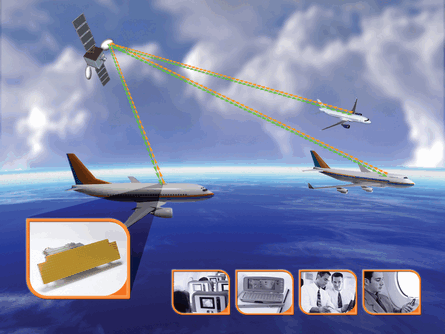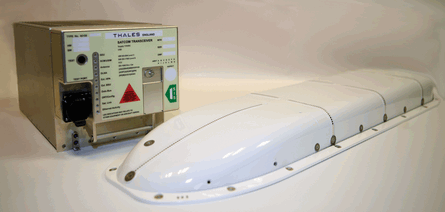At an event like Farnborough it’s always the clashes of the titans that grab the biggest headlines – Airbus versus Boeing, GE versus Pratt & Whitney versus Rolls. There are other rivalries afoot, however, and while fewer billions may be at stake, their outcome can mean almost as much to the comfort and convenience of the air-travelling public.
One such is the emerging struggle between two different approaches to filling the gap left by the failed Connexion by Boeing (CBB) and delivering broadband Internet connectivity to airliners. They are represented here by exhibitors like EMS Satcom and Rockwell Collins suppliers of equipment to work with Inmarsat’s L-band satellites, and AeroSat, provider of the aircraft antenna needed to work with the Ku-band satellite system about to be introduced by Californian company Row 44.
CBB had a big budget, a high level of engineering self-confidence and some genuinely smart ideas about the commercial relationships needed to sell its powerful Internet access service to travellers. Unfortunately, the budget finally proved to be so big – an estimated $1-1.5 billion – that corporate headquarters despaired of ever getting its money back and called it a day at the end of 2006.
To blame for the failure was imperfect execution of a very good idea – email and Internet into the cabin – and other players have since emerged to see if they can meet the undoubted demand while spending sensible amounts on system development and operation. The leading ones come from four respectable technology communities – L-band and Ku-band satellite, air-to-ground cellular, and the US ATG frequencies formerly occupied by Verizon Airfone.
 |
|---|
On the satellite side the dramatis personae comprise the Inmarsat L-band community and “Ku-band Lite” contenders Row 44, Panasonic, and a collaboration by T-Mobile and VT Miltope that has emerged from the shadows to contest the prized but problematical deal to replace CBB aboard Lufthansa. Also active in Ku-band, but focused exclusively on corporate and VIP aviation, is the ARINC/Rockwell Collins SKYLink operation.
Colorado-headquartered Aircell, with a solid track record in serving general and corporate aviation via its first-generation cellular-type system, has the most ambitious ground-based solution. It has just launched a trial of its new Mobile Broadband Network (AMBN) on a number of Boeing 767s operated domestically by American Airlines, while Virgin America remains committed to making a start on introducing the service fleet-wide before the end of the year.
In a move that surprised many but which really does make sense, US in-flight television company LiveTV recently acquired the ATG ground network that outgoing provider Verizon Airfone was about to shut down.
Having won 1MHz of ATG spectrum in the 2006 Federal Communications Commission auction that gave Aircell the 3MHz it needs for AMBN, LiveTV has effectively absorbed the Verizon Airfone capability and plans to use it to support a messaging and email service from next year. Early customers will include LiveTV parent JetBlue, which is trialling the service on one of its Airbus A320s, and Continental, which wants it for large numbers of domestic Boeing 737s and 757s.
While Aircell and LiveTV are quite credible, their technical solutions limit them to North America, and too little is publicly known about the T-Mobile/VT Miltope venture to permit any kind of assessment. Only Row 44 and Panasonic, with their plans to buy off-the-peg Ku-band satellite capacity to build coverage wherever it makes commercial sense around the world, and the Inmarsat community can pretend to the worldwide capability needed to pick up the Connexion by Boeing torch.
Founded in 2003, Row 44 is due to start flight trials later this summer on a single Alaska Airlines Boeing 737 and on four from Southwest Airlines. Both carriers say they will implement the service throughout their fleets if results are satisfactory. Meantime, the company continues to plan an international presence, starting with an extension of coverage from North America to the Atlantic and then Europe from the first quarter of next year.
 |
|---|
When IFE giant Panasonic first announced its broadband plans the target for entry into service was the fourth quarter of last year – now the company talks of some time in the first six months of next year. Final selection of the antenna, the most critical airborne system element, is believed to be imminent, and Panasonic expects to see the first set of eXconnect equipment installed in an aircraft operated by a North American carrier around the end of the year.
The plain fact is that both Row 44 and Panasonic have seen their programmes slide to the right. One of the reasons is technical – developing an effective airborne Ku-band antenna is far from straightforward. Panasonic has been whipping its would-be suppliers to come up with an antenna that combines low weight, a small physical footprint and lots of data throughput.
Then there are the economics of establishing a Ku-band satellite system. One of the things that did for Connexion by Boeing was the price it had to pay for leased capacity on existing multi-purpose Ku-band satellites. Under the practice of the day the US company had to commit expensively to whole transponders at a time, whether it needed that much capacity or not. Row 44 and Panasonic are determined not to repeat that mistake.
The two companies regard all this as a price worth paying for the big advantage of a Ku-band solution – megabits of throughput to the aircraft compared with the 432kbit/sec per channel of Inmarsat’s SwiftBroadband service. But not only does the London-based company have other strengths, it can also make the case that its rivals’ bandwidth advantage may be overstated.
Take the aircraft antenna. Far from requiring a fresh and technically risky development, SwiftBroadband works through the existing intermediate and high-gain L-band antennas already fitted to thousands of airliners to support first-generation Inmarsat services.
As for the satellite system, two out of three of the fourth-generation spacecraft needed to support SwiftBroadband are already in operation, with the third due for launch next month to complete round-the world coverage.
The Inmarsat community also has customers who have said, no if or buts, that they will use SwiftBroadband to offer email and managed Internet access services to their passengers. Service providers AeroMobile and OnAir are now launching their initial Inmarsat-based onboard mobile phone services.
OnAir plans to launch Webmail and Webchat services with two airlines this summer, with full Internet connectivity, based on relationships with WiFi aggregators like iPass and Boingo, to follow in the next 12 months. The service will be delivered to passengers’ own devices, both wirelessly and via RJ-45 cable, and through in-seat IFE systems.
Finally, the Ku-band camp makes much of its megabit credentials. But closer inspection reveals that Inmarsat could have more in the tank than first meets the eye. Though current SwiftBroadband installations are limited to two channels, they can be “bonded” to produce an 864kbit/sec pipe, and from 2012 Inmarsat will be ready to support installations comprising a pair of two-channel terminals.
Source: Flight International























